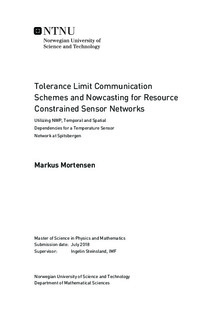Tolerance Limit Communication Schemes and Nowcasting for Resource Constrained Sensor Networks - Utilizing NWP, Temporal and Spatial Dependencies for a Temperature Sensor Network at Spitsbergen
Master thesis
Permanent lenke
http://hdl.handle.net/11250/2565279Utgivelsesdato
2018Metadata
Vis full innførselSamlinger
Sammendrag
In this thesis we consider resource constraint sensor networks that communicates with a fusion center. If communication and/or energy resources are limited, is it desirable to keep the number of transmissions from a sensor low. We suggest a communication scheme based on Temporal dependence and Tolerance limits and that is Trigger based (TTT). The TTT-communication scheme is based on, together with predictions about the process, tolerance limits and an updating scheme known to both a fusion center and a sensor. Through simulation studies we demonstrate that the number of observations a sensor monitoring a temporal process must transmit to a fusion center can be heavily reduced, without sacrificing much knowledge about the process of interest.
Further, we use the TTT-communication scheme for making hourly nowcasts of the temperature at 10 locations at Spitsbergen. In this case study we utilize weather forecasts from a physical weather model (numerical weather prediction, NWP) to improve the prediction in the TTT-communication scheme. The transmission rates for the sensors are reduced by 70−80%, while with a guaranteed maximum error of ±1◦C and RMSE below 0.45 for the nowcasted temperature.
Furthermore, by utilizing spatial dependence in the process, we extend the TTT- communication scheme to a spatial model for nowcasting, TTTS. Using the TTTS-model reduces the RMSE for the nowcasted temperature further, though with a guaranteed maximum error of ±1◦C. An algorithm for estimating the first and second moment of the truncated multivariate Gaussian variable is also presented.
